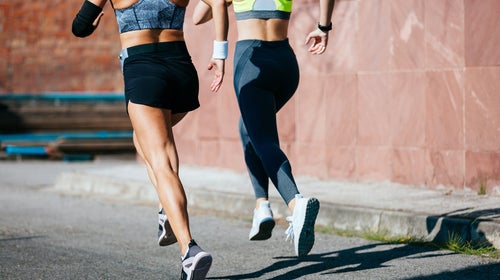The setup to a newly published study on running form feels a bit puzzling. Years—or in fact decades—of previous studies, the researchers tell us, have found that the way you run doesn’t seem to predict how efficient you are. Their new experiment will use two high-tech ways of quantifying running form to analyze the movements of 52 runners, and also assess their efficiency. Their hypothesis is that there will be no link between the efficiency data and the form data. Sure enough, that’s exactly what they find.
So why, you may wonder, did they bother doing the experiment? That’s the question that was on my mind when dropped into my inbox last week. The subject: two short videos of runners running beautifully. One was a fantastic short film from 1962 about Canadian runner Bruce Kidd, featuring a lot of long, slow takes of Kidd running. The other was about New Zealander Nick Willis’s New Year’s Eve attempt to extend his streak of sub-four-minute miling to 20 years.
Both videos are amazing and worth a watch, in very different ways. The Kidd video (which I mentioned last month in the context of Kidd’s new autobiography) is narrated by none other than W.H. Auden: “As Pindar long ago in Greece was proud to hail Thessalian Hippocleas, even so it is meet we praise in our days fleet-footed Bruce Kidd… from Toronto.” It’s a trip. The Willis video—well, if you haven’t already seen the outcome, I won’t spoil it.
The point is that Gladwell is extolling the beauty of these two world-class runners in motion. Kidd is “impossibly elegant,” he writes, and “there are lots of people who think Willis has the most beautiful form of any elite runner in the world.” I don’t think this is a purely aesthetic judgment. At least, it isn’t for me. What makes a runner’s movements seem beautiful is that they convey a sense of ease—maintaining that pace, you figure, must take less energy than a more awkward and ungainly runner would require. But that’s not what the science says.
The new study is by researchers in Switzerland, France, New Zealand, and Malaysia, led by Aurélien Patoz of the University of Lausanne. It tests two ways of quantifying running form. One is duty factor, which is how long your foot stays on the ground as a fraction of your total stride cycle. The other is a proprietary scale developed by a Swiss company called Volodalen that uses 3D motion analysis to quantify how “aerial” or “terrestrial” a runner you are.
Runners with a high duty factor (i.e., spending more time with their feet on the ground) tend to land on their heels, bend their knees and ankles more, and propel themselves forward rather than upward. Runners with a low duty factor are more likely to land on their midfoot or forefoot, keep their legs straighter, and push themselves more upward. The Volodalen scale makes similar distinctions. But in neither case do these distinctions tell you anything about efficiency.
Here, for example, is the data for efficiency (expressed as running economy, RE, which is the amount of oxygen burned to cover a given distance) as a function of duty factor (DF, in percent). The data is presented for three different speeds: 10, 12, and 14 kilometers per hour (roughly 9.5-, 8-, and 7-minute miles).

There’s nothing there. So why is it that all of us—Malcolm Gladwell, me, you, and presumably —know beautiful running form when we see it?
There are three main options. One is that we’re asking the question poorly. The new study, for example, looked only at trained runners. They had an average half marathon time of 1:31, and had been runners for an average of eight years. Among these veterans, perhaps running form doesn’t matter because it has already been optimized through years of training.
I do think you’d be more likely to pick up a signal in a more diverse population—and, in fact, I wrote a few years ago about the ability of artificial intelligence to tell the difference between the running form of competitive and recreational runners. But that’s not a satisfying answer, because you can watch an Olympic final consisting of the very best runners in the world and still be struck by the contrast between smooth and awkward gaits.
The second possibility is that we’re asking the wrong question. We’re looking at footstrike and knee-bend and elbow angle, when what we should really be looking at is… well, I don’t know. Chin angle? Belly-button rotation? Maybe there’s some telltale parameter, or overall pattern, that we intuitively recognize signifies an efficient runner. But if so, no one seems to have told running coaches about it.
The third option is that what I said above—that it’s not a purely aesthetic judgment—is wrong. We keep studying and arguing about the links between form and efficiency because, despite the accumulating piles of evidence, we can’t quite believe that there isn’t some functional benefit to running beautifully. But perhaps when we watch someone like Nick Willis glide around the track as smoothly and effortlessly as a Japanese bullet train coasting downhill, we’re not making any implicit judgment about efficiency. We’re just appreciating poetry in motion—which, I guess, is what W.H. Auden was trying to say about Bruce Kidd:
All visible visibly moving things
spin or swing, one of the two
move as the limbs of a runner do
to and fro, forward and back
or, as they swiftly carry him, in orbit go
round an endless track:
so, everywhere, every creature disporting itself
according to the law of its making
in the rivals’ dance of a balanced pair
or the ring dance around a common center
delights the eye by its symmetry as it changes place
blessing the unchangeable absolute rest
of the space they share.
Or to put it another way, Bruce Kidd runs in a way that only Bruce Kidd can run—and, despite some sort of funky hitch in his arm motion, it’s pleasing to the eye. But that doesn’t mean that you or I should try to emulate it. As the Swiss researchers write in their conclusions: “coaches should not try to modify the spontaneous running pattern of runners.” Keep on disporting yourself according to the law of your making, and your running economy will take care of itself.
For more Sweat Science, join me on and , sign up for the , and check out my book .


